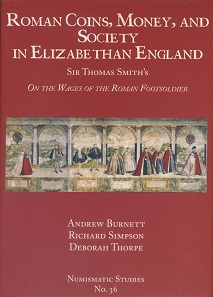Written by Ursula Kampmann
Translated by Leonie Schulze
June 14, 2018 – Have you ever shown a non-expert around a numismatic exhibition? One of the first comments you are confronted with will be: “And what could you buy yourself with that back in the day?” That this is not a modern-day question is proven by the fact that one of the earliest antiquarians from the British Isles, Sir Thomas Smith (1513-1577), dedicated a comprehensive treatise to this exact question. Up to today his handwritten reflections, which were presumably written in 1562, never appeared in print. Now they have been published for the first time along with annotations, edits and the historical context provided by Andrew Burnett, Richard Simpson, and Deborah Thorpe.
Andrew Burnett, Richard Simpson, Roman Coins, Money, and Society in Elizabethan England. Sir Thomas Smith’s „On the Wages of the Roman Footsoldier“ with a transcription by Deborah Thorpe. Numismatic Studies 36. The American Numismatic Society, New York 2017. 227 S. incl. Colored ilustrations. Hardcover. 21,7 x 30,4 cm. ISBN: 978-0-89722-352-2. US$ 80 + shipping bzw. 60 GBP.
This latest volume of the ANS’s Numismatic Studies series is more than just the publication of an outdated work of monetary history. It provides a deeper insight into the historical origin of numismatics and the integration of its representatives into the highest political ranks. Sir Thomas Smith was much more than a scholar in an ivory tower at Cambridge. He taught natural philosophy and Greek, he obtained a law degree at the University of Padua, he held the office of state secretary and was sent on diplomatic missions on behalf of the royal family. On top of that, he collected coins and published his numismatic work on the pay of the Roman soldiers.
Hence, any publication of his work must inevitably take into account the author’s biography with a special consideration of numismatics. Richard Simpson devotes himself to said biography on 71 pages. He brings the English politician and scholar to life. Reading Simpson’s descriptions comes with the side benefit of being reminded that our numismatic enthusiasm was once shared with the leading minds of every European kingdom.
In his chapter, Andrew Burnett summarizes the content of the presented book on roughly the same amount of pages and puts Smith’s findings into the context of the research of his time. He presents the three surviving manuscripts of the book, reconstructs and dates the original text and thoroughly looks for the sources that Smith used originally. He even catalogs the numismatic library that Smith had access to. We also learn that there were kindred spirits around Smith at Cambridge: consequently he did not work in a vacuum. To name just one example, William Cecil, a leading politician during the reign of Elizabeth I, also owned a fine coin collection.
Many readers of this publication will probably favor the fascinating first two chapters over the actual text written by Sir Thomas Smith. Even though it was transcribed in an exemplary manner and all of the Latin passages come with an English translation. Deborah Thorpe devoted herself to this complex and demanding task.
This engaging work is by no means a catalog that every coin dealer needs in his library. However, it is an exciting proof of how old numismatics is and how deeply rooted it once was in the world of the powerful in early modern times. It is a wonderful read for anyone who is interested in the history of numismatics!
The book was published by the ANS and can be purchased on their website.
It will probably be easier for Europeans to purchase it from Oxbow.





